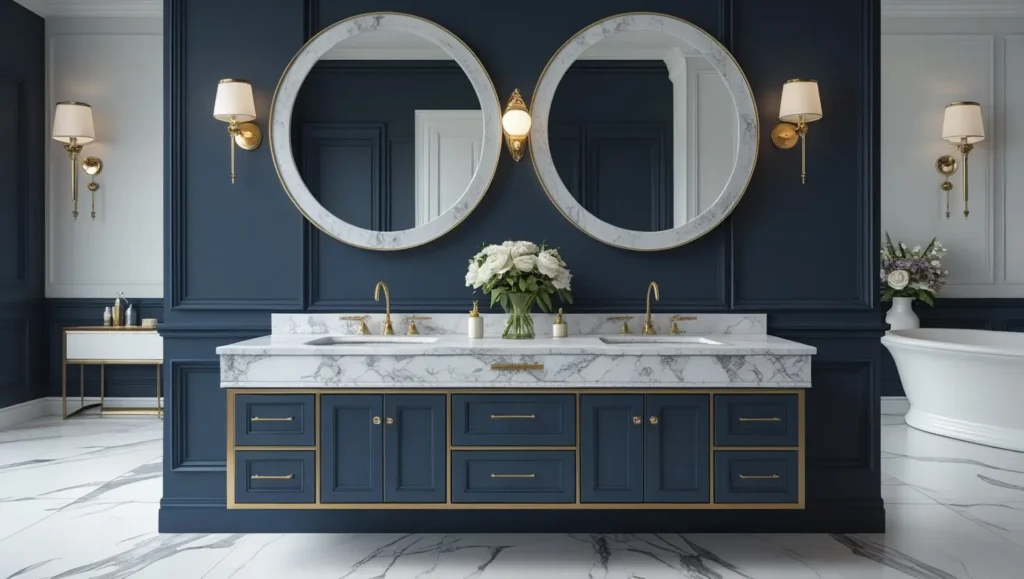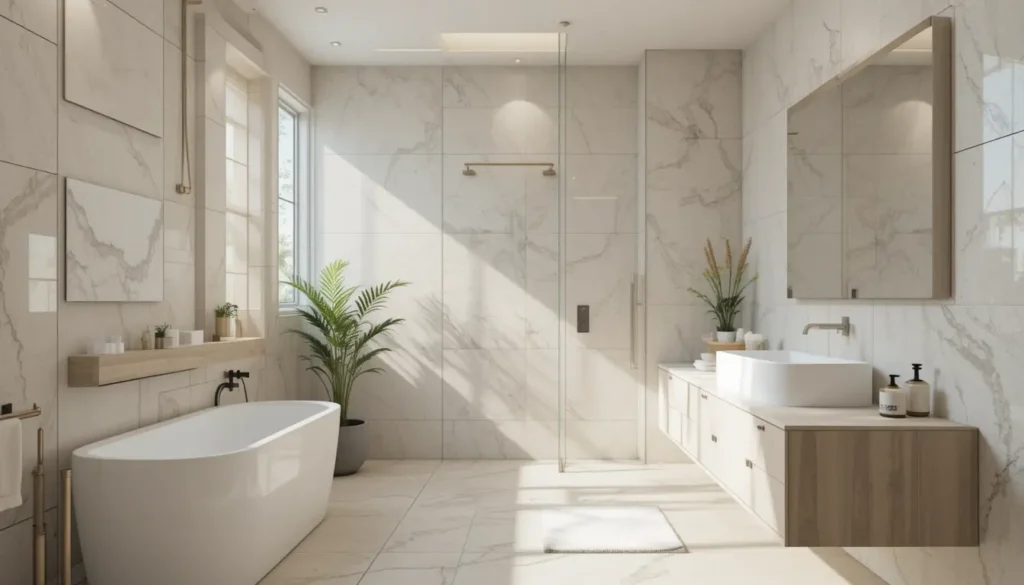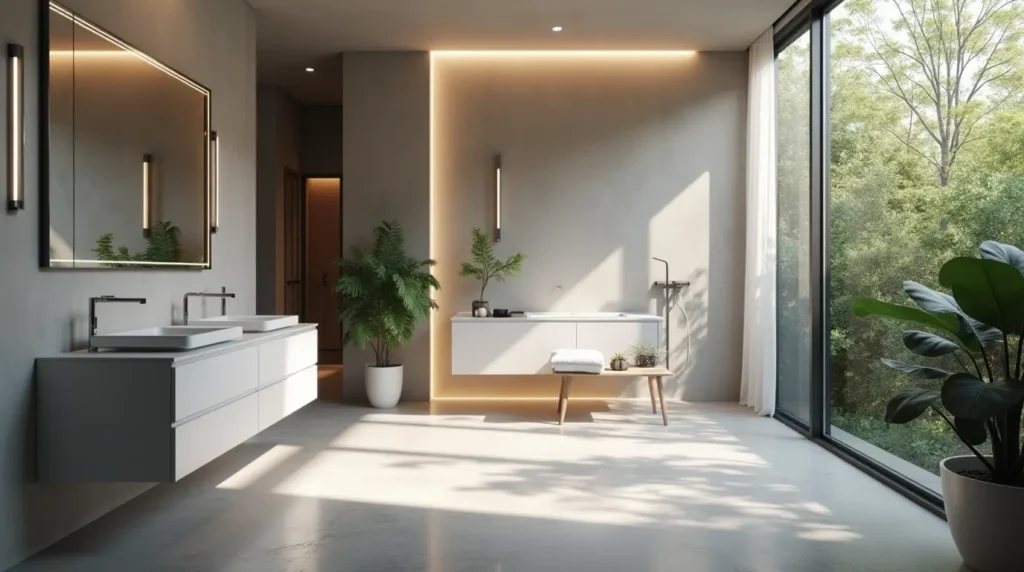Table of Contents
When it comes to modern bathroom design, few things make as big of a statement as a floating bathroom vanity. Imagine walking into a bathroom that feels spacious, sleek, and effortlessly stylish—like something out of a luxury home magazine. That’s the magic of a floating vanity! But what exactly is it, and why is it becoming the go-to choice for homeowners and designers alike?
In this guide, we’ll explore everything you need to know about floating vanities—from their benefits and styles to installation tips and common problems. Whether you’re renovating your bathroom or just dreaming of a future upgrade, this article will help you make an informed decision. Let’s get started!
What is a Floating Bathroom Vanity?
A floating bathroom vanity is exactly what it sounds like—a vanity that appears to “float” above the floor, mounted directly to the wall. Unlike traditional vanities that sit on the ground, these wall-hung beauties create an illusion of more space, making them perfect for small bathrooms or modern minimalist designs.
Definition and Key Features
At its core, a floating vanity is a bathroom cabinet that’s attached to the wall, leaving the floor beneath it completely clear. It typically includes a sink, countertop, and storage space, but the design can vary widely depending on your preferences. Some floating vanities are sleek and compact, while others are more elaborate, with multiple drawers and shelves.
One of the standout features of a floating vanity is its clean, unobstructed look. Without legs or a bulky base, it creates a sense of openness that can make even the tiniest bathroom feel larger. Plus, it’s a great way to show off your flooring, whether it’s marble tiles, hardwood, or polished concrete.
How Does a Floating Vanity Differ from Traditional Vanities?
Traditional vanities are grounded—literally. They sit on the floor, often with a solid base or legs, and can take up a lot of visual and physical space. While they’re great for storage, they can make a bathroom feel cramped, especially if it’s on the smaller side.
On the other hand, a floating vanity is all about maximizing space and creating a modern aesthetic. It’s like the difference between a clunky old desk and a sleek, wall-mounted workstation. One feels heavy and dated, while the other feels light, airy, and contemporary.
Benefits of Choosing a Floating Vanity for Your Bathroom
So, why should you consider a floating vanity for your bathroom? Let’s break it down. Spoiler alert: the benefits are pretty impressive!

Space-Saving Design for Small Bathrooms
If you’re working with a small bathroom, every inch counts. A floating vanity can be a game-changer because it frees up floor space, making the room feel larger and less cluttered. It’s like giving your bathroom a breath of fresh air!
“A floating vanity is the perfect solution for small spaces. It creates the illusion of more room while still providing all the functionality you need.” – Interior Design Expert
Easy Cleaning and Maintenance
Let’s be honest—cleaning the bathroom isn’t exactly anyone’s favorite chore. But with a floating vanity, it’s a whole lot easier. Since there’s no base or legs to worry about, you can simply mop or sweep underneath it without any hassle. No more awkwardly maneuvering around bulky furniture or dealing with hard-to-reach corners!
Modern and Sleek Aesthetic Appeal
There’s no denying it—floating vanities just look cool. They have a sleek, minimalist vibe that instantly elevates the look of any bathroom. Whether you’re going for a modern, industrial, or even a rustic style, a floating vanity can be customized to fit your vision. It’s like the little black dress of bathroom design—timeless, versatile, and always in style.
Customizable Height and Storage Options
One of the best things about floating vanities is their flexibility. Unlike traditional vanities, which come in standard sizes and heights, a floating vanity can be installed at whatever height works best for you. This is especially great for families with kids or taller adults who don’t want to hunch over the sink.
Plus, you can choose from a variety of storage options, from open shelves to hidden cabinets. Want a minimalist look? Go for a single drawer or no storage at all. Need more space for toiletries and towels? Opt for a vanity with multiple drawers and compartments. The choice is yours!
Popular Styles and Designs of Floating Vanities
Now that you know the benefits, let’s talk about the different styles and designs available. After all, a floating vanity isn’t just functional—it’s also a statement piece that can define the entire look of your bathroom.
Minimalist Floating Vanities
If you’re a fan of clean lines and understated elegance, a minimalist floating vanity might be right up your alley. These vanities are all about simplicity, with smooth surfaces, neutral colors, and no unnecessary frills. Think of it as the “less is more” approach to bathroom design.
Rustic and Wooden Floating Vanities
For a warmer, more natural look, consider a rustic floating vanity made of wood. Whether it’s reclaimed timber, oak, or walnut, a wooden vanity adds warmth and character to your bathroom. Pair it with a stone countertop and some vintage fixtures, and you’ve got a bathroom that feels cozy and inviting.
Industrial-Style Wall-Hung Vanities
Love the look of exposed pipes, metal accents, and raw materials? An industrial-style floating vanity might be just what you need. These vanities often feature metal frames, concrete countertops, and open shelving, giving your bathroom an edgy, urban vibe.
Luxury Floating Vanities with Modern Sink Designs
If you’re looking to splurge, why not go for a luxury floating vanity? These high-end options often come with premium materials like marble or quartz, as well as modern sink designs like vessel sinks or integrated basins. Add some gold or brass hardware, and you’ve got a bathroom that screams sophistication.
How to Choose the Perfect Floating Vanity for Your Bathroom
Choosing the right floating vanity can feel overwhelming, but don’t worry—we’ve got you covered. Here are some key factors to consider before making your decision.
Consider Your Bathroom Size and Layout
First things first: measure your bathroom! A floating vanity should fit seamlessly into your space without overwhelming it. If you have a small bathroom, opt for a compact design with minimal storage. For larger bathrooms, you can go bigger and bolder.
Material Selection: Wood, Glass, Metal, or Composite?
The material you choose will have a big impact on the look and durability of your vanity. Wood is warm and timeless, glass is sleek and modern, metal is sturdy and industrial, and composite materials are affordable and versatile. Think about what fits your style and budget.
Matching Your Vanity with Bathroom Decor
Your floating vanity should complement the rest of your bathroom decor, not clash with it. If you have a monochromatic color scheme, consider a vanity in a contrasting shade to make it pop. If your bathroom is already busy with patterns and textures, go for something simple and understated.
Budget-Friendly vs. High-End Floating Vanities
Floating vanities come in a wide range of prices, so it’s important to set a budget before you start shopping. Keep in mind that while high-end vanities may look stunning, there are plenty of affordable options that offer great quality and style.
Installation Guide for Floating Bathroom Vanities
So, you’ve decided to take the plunge and install a floating vanity in your bathroom. Exciting! But before you grab your toolbox, let’s talk about what you need to know to get the job done right. Installing a floating vanity isn’t rocket science, but it does require some planning and precision. Don’t worry—I’ll walk you through it step by step.
Tools and Materials Needed
First things first, let’s gather your tools and materials. Here’s what you’ll need:
- Measuring tape (to ensure everything is level and aligned)
- Stud finder (to locate the wall studs for secure mounting)
- Drill and screws (for attaching the vanity to the wall)
- Level (to make sure your vanity isn’t crooked)
- Pencil (for marking measurements)
- Plumbing tools (if you’re connecting the sink and faucet yourself)
- Safety gear (gloves, goggles, and maybe a hard hat if you’re feeling extra cautious)
“The key to a successful installation is preparation. Take your time to measure twice and drill once!” – DIY Enthusiast
Step-by-Step Installation Process
- Plan Your Layout: Start by deciding where you want your vanity to go. Use your measuring tape to mark the height and width on the wall. Remember, the standard height for a vanity is around 30-36 inches, but you can adjust this based on your preference.
- Locate the Studs: Use a stud finder to locate the wall studs. Floating vanities need to be securely anchored to the studs to support the weight. Mark the stud locations with a pencil.
- Attach the Mounting Bracket: Most floating vanities come with a mounting bracket. Secure this bracket to the wall studs using your drill and screws. Double-check that it’s level before tightening everything.
- Install the Vanity: Once the bracket is secure, carefully lift the vanity and slide it onto the bracket. Make sure it’s level and aligned with your markings. Secure it in place with screws.
- Connect the Plumbing: If you’re comfortable doing so, connect the sink and faucet to the plumbing. If not, this might be a good time to call in a professional plumber.
- Add the Finishing Touches: Install any drawers, shelves, or doors that came with your vanity. Step back and admire your handiwork!
Common Installation Mistakes to Avoid
- Skipping the Studs: Never mount a floating vanity directly to drywall. It won’t hold the weight, and you’ll end up with a vanity on the floor—and a big hole in your wall.
- Ignoring the Level: A crooked vanity is a eyesore. Take the time to ensure everything is perfectly level before securing it.
- Forgetting About Plumbing: Make sure the plumbing lines up with your vanity before you start drilling. There’s nothing worse than realizing your pipes are in the wrong place after the vanity is installed.
Common Problems with Floating Vanities and Their Solutions
Like anything in life, floating vanities come with their own set of challenges. But don’t worry—most of these problems have simple solutions. Let’s take a look at some of the most common issues and how to fix them.
Issue: Wall Strength and Support
One of the biggest concerns with floating vanities is whether your wall can support the weight. After all, you don’t want your beautiful new vanity crashing down in the middle of the night!
Solution: Reinforcing Walls for Heavy Loads
If you’re worried about wall strength, consider reinforcing the wall before installation. You can add extra studs or use heavy-duty mounting brackets designed to distribute the weight more evenly. If you’re not sure, consult a contractor to assess your wall’s capacity.
Issue: Plumbing Visibility
Since floating vanities don’t have a base, the plumbing underneath can be visible. For some, this is a cool industrial look; for others, it’s an eyesore.
Solution: Creative Plumbing Concealment Techniques
If you’re not a fan of exposed pipes, there are ways to hide them. You can install a decorative panel or skirt around the base of the vanity, or even use a floating shelf to cover the plumbing. Another option is to choose a vanity with a built-in back panel that hides the pipes.
Issue: Limited Storage Space
Floating vanities are sleek and stylish, but they often come with less storage than traditional vanities. If you’re someone who needs space for all your toiletries, this can be a problem.
Solution: Maximizing Storage with Smart Design
The key here is to get creative with your storage. Look for vanities with deep drawers, pull-out shelves, or built-in organizers. You can also add wall-mounted shelves or baskets to keep essentials within reach. Remember, it’s all about working with the space you have.
Maintenance Tips for Floating Bathroom Vanities
Once your floating vanity is installed, you’ll want to keep it looking its best. Luckily, maintenance is pretty straightforward—if you know what you’re doing. Here are some tips to keep your vanity in tip-top shape.
Cleaning and Care for Different Materials
The way you clean your vanity will depend on the material it’s made from. Here’s a quick guide:
- Wood: Use a mild soap and water solution, and avoid harsh chemicals that can damage the finish. Dry immediately to prevent water spots.
- Glass: Wipe down with a glass cleaner or vinegar solution to keep it streak-free.
- Metal: Use a damp cloth and a gentle cleaner to remove fingerprints and smudges.
- Composite: These materials are usually low-maintenance—just wipe them down with a damp cloth.
Preventing Water Damage and Mold
Since floating vanities are mounted to the wall, they’re less likely to suffer from water damage than traditional vanities. However, it’s still important to keep an eye out for leaks or moisture buildup. Make sure your plumbing is in good condition, and use a waterproof sealant around the edges of your vanity if necessary.
Regular Inspection for Loose Fixtures
Over time, screws and brackets can loosen, especially if your vanity gets a lot of use. Make it a habit to check the mounting hardware every few months and tighten anything that feels loose. This will help prevent accidents and keep your vanity secure.
Top 5 Floating Vanity Brands to Consider
If you’re ready to shop for a floating vanity, here are five brands that consistently deliver quality, style, and functionality. Whether you’re looking for something budget-friendly or high-end, there’s something here for everyone.
Brand 1: Overview and Product Range
IKEA: Known for its affordable and modern designs, IKEA offers a range of floating vanities that are perfect for small spaces. Their products are easy to assemble and come in a variety of styles and finishes.
Brand 2: Unique Features and Designs
Kohler: If you’re looking for luxury, Kohler is the way to go. Their floating vanities feature high-end materials like marble and quartz, as well as innovative storage solutions.
Brand 3: Affordable and Stylish Options
Home Depot: With a wide selection of floating vanities at various price points, Home Depot is a great place to start your search. They offer everything from basic models to more elaborate designs.
Brand 4: Luxury Floating Vanities
Rohl: For those who want the best of the best, Rohl offers luxurious floating vanities with handcrafted details and premium materials. These vanities are an investment, but they’re worth every penny.
Brand 5: Eco-Friendly and Sustainable Choices
Bamboo Bath: If sustainability is important to you, check out Bamboo Bath. Their floating vanities are made from eco-friendly materials like bamboo and reclaimed wood, making them a great choice for environmentally conscious homeowners.
Floating Vanity vs. Traditional Vanity: Which is Better?
Ah, the age-old debate: floating vanity or traditional vanity? Both have their pros and cons, and the best choice depends on your needs, style, and bathroom layout. Let’s break it down so you can decide which one is right for you.
Pros and Cons of Floating Vanities
Pros:
- Space-Saving: Perfect for small bathrooms, as they free up floor space and make the room feel larger.
- Modern Aesthetic: Sleek, minimalist, and stylish—ideal for contemporary designs.
- Easy to Clean: No legs or base means no hard-to-reach spots for cleaning.
- Customizable Height: You can install it at whatever height works best for you.
Cons:
- Limited Storage: Often comes with less storage space than traditional vanities.
- Installation Complexity: Requires secure wall mounting, which can be tricky if you’re not handy.
- Visible Plumbing: Unless concealed, the pipes underneath can be an eyesore for some.
Pros and Cons of Traditional Vanities
Pros:
- Ample Storage: Typically offers more drawers and cabinets for storing bathroom essentials.
- Sturdy and Durable: Grounded design provides stability and can support heavier countertops.
- Classic Look: Works well in traditional or rustic bathroom designs.
- Easier Installation: Doesn’t require wall studs or complex mounting.
Cons:
- Bulky Design: Takes up more floor space, making small bathrooms feel cramped.
- Harder to Clean: Legs and bases create nooks and crannies that are difficult to clean.
- Less Modern: May look outdated in contemporary or minimalist bathrooms.
Making the Right Choice for Your Bathroom
So, which one should you choose? Here’s a quick guide to help you decide:
- Choose a Floating Vanity If: You have a small bathroom, love modern design, and don’t need a ton of storage.
- Choose a Traditional Vanity If: You have a larger bathroom, prefer a classic look, and need plenty of storage space.
At the end of the day, it’s all about what works best for your space and lifestyle. Why not mix and match? For example, you could use a floating vanity in a powder room and a traditional vanity in the main bathroom.
Creative Ideas for Styling Your Floating Vanity
A floating vanity is more than just a functional piece—it’s a design statement. Here are some creative ideas to make your vanity the star of your bathroom.

Adding Decorative Lighting
Lighting can completely transform the look of your vanity. Consider installing sconces on either side of the mirror for a soft, flattering glow. Or, go for a statement pendant light above the vanity to add a touch of drama.
“Lighting is the jewelry of your bathroom. It can elevate a simple vanity into a showstopper.” – Interior Designer
Incorporating Mirrors and Artwork
A mirror is a must for any vanity, but why stop there? Choose a mirror with an interesting frame—think bold shapes, metallic finishes, or rustic wood. You can also hang artwork above the vanity to add personality and color to the space.
Pairing with Modern Faucets and Sinks
The faucet and sink you choose can make or break your vanity’s look. For a modern vibe, opt for a sleek, wall-mounted faucet and a vessel sink. If you prefer a more traditional feel, go for a classic chrome faucet and an under-mount sink. Don’t be afraid to mix and match styles for a unique look.
Frequently Asked Questions About Floating Bathroom Vanities
Let’s tackle some of the most common questions people have about floating vanities. Whether you’re a DIY enthusiast or a first-time buyer, these answers will help clear up any confusion.
Can Floating Vanities Support Heavy Countertops?
Yes, but with a caveat. Floating vanities can support heavy materials like marble or quartz, but the wall and mounting system must be strong enough to handle the weight. Reinforce the wall with additional studs or use heavy-duty brackets for extra support.
Are Floating Vanities Suitable for Families?
Absolutely! Floating vanities are great for families because you can install them at a height that works for both adults and kids. Just make sure to choose a design with enough storage to accommodate everyone’s needs.
How Much Weight Can a Floating Vanity Hold?
The weight capacity depends on the wall structure and mounting system. On average, a properly installed floating vanity can hold between 200-300 pounds. Always check the manufacturer’s guidelines and consult a professional if you’re unsure.
Can I Install a Floating Vanity Myself?
If you’re handy and have some DIY experience, you can definitely install a floating vanity yourself. However, if you’re dealing with plumbing or heavy materials, it’s best to call in a professional to avoid costly mistakes.
What is the Average Cost of a Floating Vanity?
The cost of a floating vanity can vary widely depending on the material, size, and brand. On average, you can expect to pay anywhere from 200forabasicmodelto200forabasicmodelto2,000 or more for a high-end design. Don’t forget to factor in installation costs if you’re hiring a professional.
Conclusion: Why a Floating Vanity is a Game-Changer for Modern Bathrooms
So, there you have it—everything you need to know about floating bathroom vanities! From their space-saving design and modern aesthetic to their customizable features and easy maintenance, it’s no wonder they’re becoming a favorite among homeowners and designers alike.
Recap of Benefits and Design Versatility
Floating vanities offer a unique combination of style and functionality. They’re perfect for small spaces, easy to clean, and can be customized to fit any design aesthetic. Whether you’re going for a minimalist look, a rustic vibe, or a luxurious feel, there’s a floating vanity out there for you.
Final Tips for Choosing and Maintaining Your Vanity
- Measure Twice, Buy Once: Make sure your vanity fits your space and meets your storage needs.
- Invest in Quality: A well-made vanity will last for years, so don’t be afraid to splurge on something you love.
- Keep It Clean: Regular maintenance will keep your vanity looking like new for years to come.
So, what are you waiting for? It’s time to take your bathroom to the next level with a stunning floating vanity. Trust me, once you go floating, you’ll never go back! 🚀




1 thought on “Floating Bathroom Vanity: The Ultimate Guide to Modern Bathroom Design”